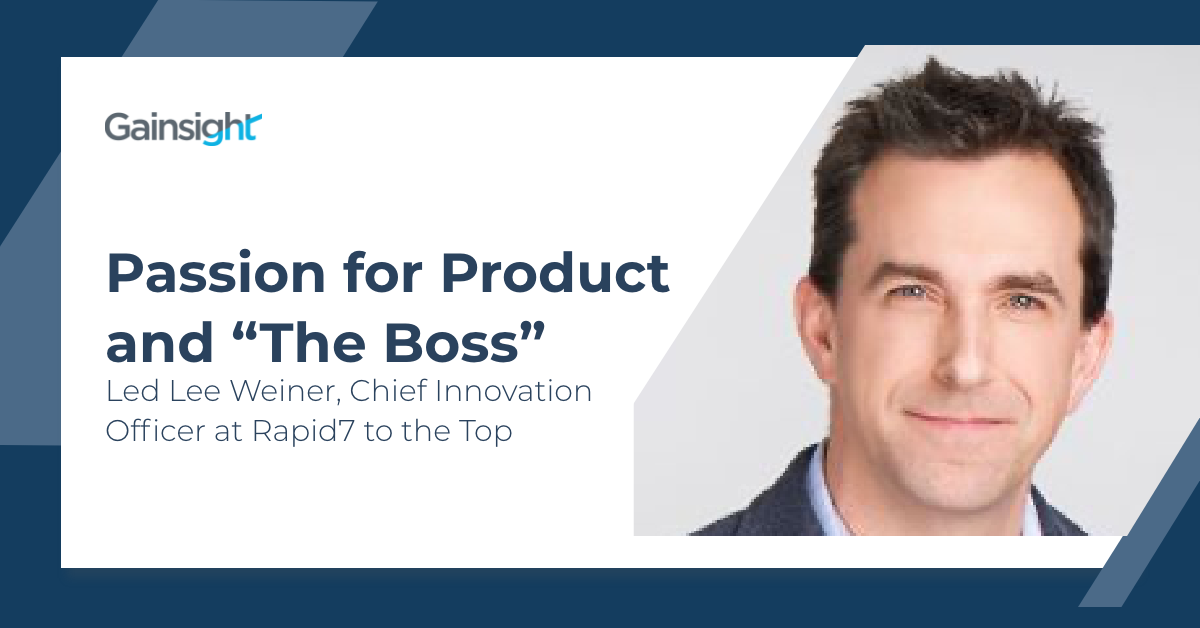Over the past year, Gainsight’s CEO, Nick Mehta, has interviewed a plethora of Chief Product Officers in the series Path to Becoming A CPO. As Nick explained in a recent conversation with Lee Weiner, Chief Innovation Officer at Rapid7, there was no direct path to the top early in all their careers. By sharing each story of the fantastic CPOs who inspire us at Gainsight, we hope to find commonality amongst everyone’s diversity. Perhaps, those can become markers along career paths for others.
Early in 2020, Lee Weiner became the Chief Innovations Officer at Rapid 7, a leading global technology and security services company based in Boston, Massachusetts. Rapid7 ensures reduced risks and vulnerabilities with visibility, analytics, and automation across a connected environment with a multi-product platform through advanced cloud-based technology. Through solutions, services, research, and guidance, they monitor your domain for malicious behavior, investigate and shut down attacks, and automate routine tasks. With over 9,000 customers, they have seen immense growth over the past ten years. Lee has been with Rapid7 for seven years, beginning as their Vice President of Product, back in June of 2012. But his connection with Nick started years ago at Symantec. Neither could guess where their career course would take them.
No One Path to Success
As we discovered, there is no one path for a Chief Innovation or Product Officer. In Lee’s case, he has done both. Rapid7 has structured divisions into various segments, one being growth practices, their more prominent product lines. The second is its emerging practices, which are cloud security practices. The last is automation practices, known for bringing new ideas to life on their platform. All their organizations are structured and aligned with customer-centricity in mind.
Lee’s career began in the mid-nineties at a technology publishing company, IDG, specifically at CIO Magazine. As a web developer, his job was to get static content online and make it more data-driven and dynamic. After leaving CIO, he wanted to pursue something more in the business technology field as a sales engineer for a small software firm in Boston. They quickly realized that Lee understood technology but also communicated well. That opened the door for him to be more customer-facing. It also made Lee aware of his passion for Product.
Passion for Product
Passion for Product is a common theme amongst all of Nick’s interviewees. Lee’s passion led him to a PM team, then to an engineering team, and finally managed a sales engineering team. Each job led Lee to a new location both on the east and west coasts. No matter where he went, Lee could not get away from his desire to be in Product. “I wanted to get into product management,” Lee said. “When I was at my interview, people called me for, they were like, well, look, you don’t have product management experience. What you have is great, but you’ve never done it [product management].”
Lee’s lack of experience did not stop him or even slow him down. He ended up in a sales engineering role in New York City. Within a year, he joined the product management team. With every position Lee moved to, he learned to listen and understand customer needs. Being able to articulate to the prospect and working with them on their technology is critical to product management. These core skills are what Lee thinks helped him climb to new and better positions. But it also lies in the revelation of a favorite musician—Bruce Springsteen.
The Boss
For anyone who has not heard of Bruce Springsteen or “The Boss” as many refer to him, you have missed out not only on someone who is considered America’s most incredible rock musician but a true storyteller. There is something about Springsteen’s music’s nuances that tells the story of the everyday individual who struggles to attain their dreams. There is a desire to be heard, understood, loved, to matter, and to be a success woven in Springsteen’s lyrics. That earnestness is something that, whether one realizes it or not, is a cornerstone of customer centricity and success. Every customer wants to be heard, understood, to matter, and ultimately be a success. Lee can’t be considered a mere fan. He is a loyal follower, having seen Springsteen 75 times. Somewhere in Bruce’s music, Product and customer-centricity is an enthusiasm that mirrors each other. It is a “power drive” that matches strength with a passion for accomplishing desired goals.
Varied Roles and a Range of Experience
Nick noted that being a Sales Engineer (SE) can be an excellent path to take to the C-suite. In being an SE, you learn so much about customer needs. There is also the acquired understanding of presenting the product and a demand to know the technology. Without those things, you can’t succeed. You can’t understand and give what the customer needs most, which is the insight into how the product can make them successful.
There are lessons to be learned about Lee’s self-advocacy that can help put you on the map with any career journey. For him, he tried to be tied closely to the Product and the Product team. For example, he always wanted to bring some knowledge back to the Product team as an SE. “I remember at my job when I first became an asset,” Lee explained. “I learned the API. I tried to work with customers that would bring enhancements back to the engineering team.”
Though Lee had done web development, he knew that writing code wasn’t his forte. However, he stayed close to the Product team while working with the engineers, being collaborative, supportive, and productive with his feedback. What was also a great help was having a CEO who was a “Product person.” Having leadership that embraces the vision of the role of the Product is essential to customer success. Without a good product and constant improvement on it, the customer won’t reach their desired goals. And for Lee, he made sure that his interest in the Product was clear and understood by his leadership.
Diversity in Your Surroundings
Being around a diverse group of people can have an incredible impact on your career, and much of it lies in your ability to take in their talents and skills through observation. Lee said, “Watching people, the teams, I think there’s a real benefit to kind of absorbing that, observing that, and understanding that.” He noted that his journey included companies that were a success, were acquired and even failed. Fear of change should not inhibit you. He also realized that titles should not deter you. “I’m not crazy about titles generally,” Lee explained. “But the title thing to me doesn’t determine success at all.” Lee is more interested in pursuing the knowledge and experience of each new position.
Eventually, Lee found that with all his understanding, he could create teams with balance. “Your role shifts from tactics and prioritization, planning to guidance, alignment, motivation, and strategic direction. And you have to think about how you work differently, how you engage with people. How you make decisions based on input from the team and your knowledge.”
Creating Innovation and Autonomy Through Teams
Being uncomfortable can be the springboard for creativity. That motion cannot happen without endowing people with a level of autonomy and trusting their skill set. However, Lee noted that with diversity comes conflict.
“Most people in these roles at the companies we work at, they’re passionate, they care, they’re interested in the product. So, in those cases, what happens is there’s conflict, which can be great, frankly. I mean, that’s how you get to a better outcome, a better answer as a leader. You have to manage that conflict and make it productive.”
Lee and Rapid7’s method is creating three-person teams—a product leader or product management leader, an engineering leader, and a User Experience (UX) leader on a problem area of a product. According to Lee, “If you get those three people to work well together, you can get an awesome output from that. And so, we try to create these groups of people working together on a certain problem area close to the customer, focused on the customer so we can get great outcomes.”
Rapid7 structures these teams to have a practice leader, which runs PMs, UX, and engineering. Also, a customer support advisor works with customer support on the customer success team, focused on usability, adaptability, and onboarding. They tie those things altogether. “It’s usually just a couple of people, not a huge team,” Lee shared, “but they’re responsible for that broader customer experience, not just the user experience.” Rapid7 has another role in the practice focused on the sale’s technical aspects with the SE team. The process is constructed, so individuals with specific backgrounds and experience work with the team and the sales team to evaluate and adopt for first-time use.
Seek to Understand
It is in differences that you can find strength. Taking from a previous manager, Lee often uses the phrase “Seek to understand, and then be understood.” But Lee added that though he learned from this individual, he did not see him as a “true mentor.” Lee found a constant culling of practice, understanding, and collaboration from everyone around him throughout his career. It did not matter their position or title. The leaders he found the most beneficial were those willing to share the table. Even with his CEO, Corey Thomas, at Rapid7, there is an emphasis on change management and broad leadership. Lee does not shy away from asking questions and leaning into the knowledge Corey’s leadership can give. There will always be the seminal, visionary leaders, such as Steve Jobs, who bring untapped optimism and possibility to Lee. But those are unusual and rare.
Lee believes there is value from surrounding yourself with those who are equally creative and innovative. Even more, you have to look to yourself to want to follow the path to management, deciding if it is worth the complexity it brings. Be honest with yourself and ask if you have leadership traits and skills to understand others and the process. If so, like Bruce said, “you were born to run.”

